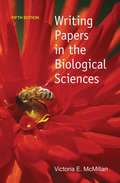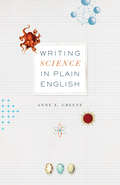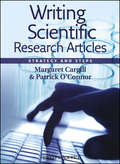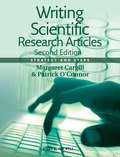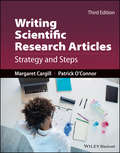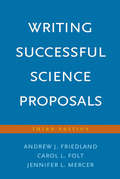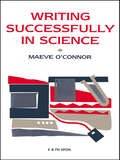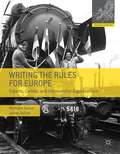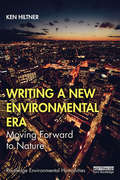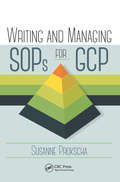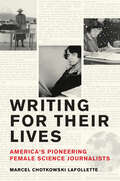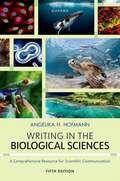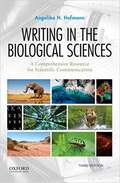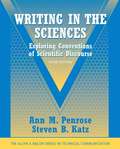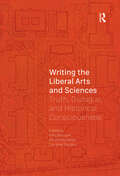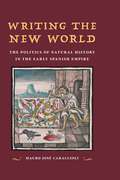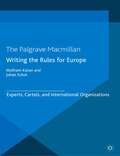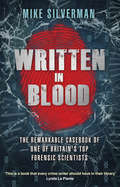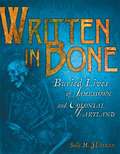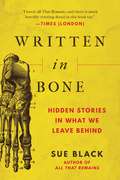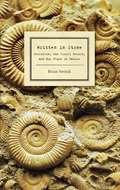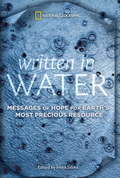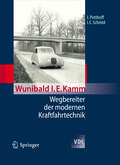- Table View
- List View
Writing Papers in the Biological Sciences (Fifth Edition)
by Victoria E. McmillanWritten by a professional biologist who is also an experienced writing teacher, this comprehensive guide for students writing in biology, zoology, and botany provides detailed instruction on researching, drafting, revising, and documenting papers, reviews, poster presentations, and other forms of writing.
Writing Science in Plain English
by Anne E. GreeneScientific writing is often dry, wordy, and difficult to understand. But, as Anne E. Greene shows in Writing Science in Plain English,writers from all scientific disciplines can learn to produce clear, concise prose by mastering just a few simple principles. This short, focused guide presents a dozen such principles based on what readers need in order to understand complex information, including concrete subjects, strong verbs, consistent terms, and organized paragraphs. The author, a biologist and an experienced teacher of scientific writing, illustrates each principle with real-life examples of both good and bad writing and shows how to revise bad writing to make it clearer and more concise. She ends each chapter with practice exercises so that readers can come away with new writing skills after just one sitting. Writing Science in Plain English can help writers at all levels of their academic and professional careers--undergraduate students working on research reports, established scientists writing articles and grant proposals, or agency employees working to follow the Plain Writing Act. This essential resource is the perfect companion for all who seek to write science effectively.
Writing Science in Plain English, Second Edition (Chicago Guides to Writing, Editing, and Publishing)
by Anne E. GreeneAn updated edition of the essential guide for all scientists—from undergraduates to senior scholars—who want to produce prose that anyone can understand. Scientific writing is often dry, wordy, and difficult to understand. But, as biologist and experienced teacher of scientific writing Anne E. Greene shows in Writing Science in Plain English, writers from all scientific disciplines can learn to produce clear, concise prose by mastering just a few simple principles. This short, focused guide presents roughly a dozen such principles based on what readers need to understand complex information, including concrete subjects, strong verbs, consistent terms, organized paragraphs, and correct sentence structure. Greene illustrates each principle with real-life examples of both good and bad writing and shows how bad writing might be improved. She ends each chapter with revision exercises (and provides suggested answers in a separate key) so that readers can come away with new writing skills after just one sitting. To help readers understand the grammatical terms used in the book, an appendix offers a refresher course on basic grammar. For this second edition, Greene has incorporated the latest research on what makes writing effective and engaging and has revised or replaced exercises and exercise keys where needed. She has also added new features that make it easier to navigate the book. A new resource for instructors who use Writing Science in Plain English in their classes is a free, online teacher’s guide. Drawn from Greene’s long experience teaching students how to write science clearly, the teacher’s guide provides additional lectures, assignments, and activities that will inform and enliven any class.
Writing Scientific Research Articles
by Patrick O'Connor Margaret CargillThis book shows scientists how to apply their analysis and synthesis skills to overcoming the challenge of how to write, as well as what to write, to maximise their chances of publishing in international scientific journals.The book uses analysis of the scientific article genre to provide clear processes for writing each section of a manuscript, starting with clear 'story' construction and packaging of results. Each learning step uses practical exercises to develop writing and data presentation skills based on reader analysis of well-written example papers. Strategies are presented for responding to referee comments, and for developing discipline-specific English language skills for manuscript writing and polishing.The book is designed for scientists who use English as a first or an additional language, and for individual scientists or mentors or a class setting. In response to reader requests, the new edition includes review articles and the full range of research article formats, as well as applying the book's principles to writing funding applications.Web support for this book is available at www.writeresearch.com.au
Writing Scientific Research Articles: Strategy and Steps
by Patrick O'Connor Margaret CargillThis book shows scientists how to apply their analysis and synthesis skills to overcoming the challenge of how to write, as well as what to write, to maximise their chances of publishing in international scientific journals. The book uses analysis of the scientific article genre to provide clear processes for writing each section of a manuscript, starting with clear ‘story’ construction and packaging of results. Each learning step uses practical exercises to develop writing and data presentation skills based on reader analysis of well-written example papers. Strategies are presented for responding to referee comments, and for developing discipline-specific English language skills for manuscript writing and polishing. The book is designed for scientists who use English as a first or an additional language, and for individual scientists or mentors or a class setting. In response to reader requests, the new edition includes review articles and the full range of research article formats, as well as applying the book’s principles to writing funding applications. Web support for this book is available at www.writeresearch.com.au
Writing Scientific Research Articles: Strategy and Steps
by Patrick O'Connor Margaret CargillWriting Scientific Research Articles The new edition of the popular guide for novice and professional scientists alike, providing effective strategies and step-by-step advice for writing scientific papers for publicationFor scientists writing a research article for submission to an international peer-reviewed journal, knowing how to write can be as important as knowing what to write. Writing Scientific Research Articles: Strategy and Steps provides systematic guidance on writing effective scientific papers with the greatest chance for publication. Using clear language, this highly practical guide shows scientists how to apply their analysis and synthesis skills to produce a compelling research article and increase their competence in written communication of science.The third edition is fully revised to reflect changes in the review process and science journal publication. Incorporating current developments in technology and pedagogical practice, brand-new sections cover mapping and planning manuscripts, choosing results, systematic reviews, structured abstracts, and more. Updated material on referee criteria offers valuable insights on what journal editors and referees want to publish and why. Offering a hands-on approach to developing the academic writing skills of scientists in all disciplines and from all language backgrounds, Writing Scientific Research Articlesprovides a genre-based pedagogy and clear processes for writing each section of a manuscript across the full range of research article formats and funding applicationspresents tested strategies for responding to referee comments and developing discipline-specific language skills for manuscript writing and polishingpairs each learning step with updated practical exercises to develop writing and data presentation skills based on expert analysis of well-written papers, including provided example articlesincludes chapters on the difference between review papers and research papers, and on skill development using journal clubs and writing groupsfeatures a wealth of new information on topics including Open Access publishing, online reviews, and predatory conferences and journalsDesigned for use by individuals as a self-study guide or by groups working with an instructor, Writing Scientific Research Articles: Strategy and Steps is a must-have guide for early-career researchers with limited writing experience, scientists for whom English is an additional language, upper-level undergraduates and graduate students writing for publication, and STEM and English language professionals involved in teaching manuscript writing and publication skills and mentoring students and colleagues.
Writing Successful Science Proposals: Third Edition
by Andrew J. Friedland Carol L Folt Jennifer L. MercerAn authoritative how-to guide that explains every aspect of science proposal writing This fully revised edition of the authoritative guide to science proposal writing is an essential tool for any researcher embarking on a grant or thesis application. In accessible steps, the authors detail every stage of proposal writing, from conceiving and designing a project to analyzing data, synthesizing results, estimating a budget, and addressing reviewer comments and resubmitting. This new edition is updated to address changes and developments over the past decade, including identifying opportunities and navigating the challenging proposal funding environment. The only how-to book of its kind, it includes exercises to help readers stay on track as they develop their grant proposals and is designed for those in the physical, life, environmental, biomedical, and social sciences, as well as engineering.
Writing Successfully in Science
by Maeve O'Connor"Writing Successfully in Science" pays particular attention to the needs of scientists whose first language is not English, explaining how to avoid the main pitfalls of English grammar and how to present work in a clear and logical fashion. It combines practical tips for the first-time writer with useful instructions for experienced contributors wishing to improve their technique.
Writing The Rules For Europe: A Practical Guide To The Future
by Wolfram Kaiser Johan SchotTechnologies have created crucial connections across borders requiring new forms of regulation. This book analyzes how experts, cartels and international organizations have written the rules for Europe since around 1850. Based on fresh research in the archives of multiple international organizations and European countries it explores the "hidden integration" of Europe forms of integration that were not always visible, but affected the citizens of Europe in their everyday lives. Richly illustrated and engagingly written, the book de-centers the present-day European Union in a new long-term understanding of European integration. "
Writing a New Environmental Era: Moving forward to nature (Routledge Environmental Humanities)
by Ken HiltnerWriting a New Environmental Era first considers and then rejects back-to-nature thinking and its proponents like Henry David Thoreau, arguing that human beings have never lived at peace with nature. Consequently, we need to stop thinking about going back to what never was and instead work at moving forward to forge a more harmonious relationship with nature in the future. Using the rise of the automobile and climate change denial literature to explore how our current environmental era was written into existence, Ken Hiltner argues that the humanities—and not, as might be expected, the sciences—need to lead us there. In one sense, climate change is caused by a rise in atmospheric CO2 and other so-called greenhouse gases. Science can address this cause. However, approached in another way altogether, climate change is caused by a range of troubling human activities that require the release of these gases, such as our obsessions with cars, lavish houses, air travel and endless consumer goods. The natural sciences may be able to tell us how these activities are changing our climate, but not why we are engaging in them. That’s a job for the humanities and social sciences. As this book argues, we need to see anthropogenic (i.e. human-caused) climate change for what it is and address it as such: a human problem brought about by human actions. A passionate and personal exploration of why the Environmental Humanities matter and why we should be looking forward, not back to nature, this book will be essential reading for all those interested in the future and sustainability of our planet.
Writing and Managing SOPs for GCP
by Susanne ProkschaThis book discusses managing SOPs for GCP from conception to retirement. It recommends approaches that have a direct impact on improving SOP and regulatory compliance. Throughout the text, the book provides a user's point of view to keep topics focused on the practical aspects of SOPs and SOP management.
Writing for Their Lives: America’s Pioneering Female Science Journalists
by Marcel Chotkowski LaFolletteA breathtaking history of America&’s trail-blazing female science journalists—and the timely lessons they can teach us about equity, access, collaboration, and persistence.Writing for Their Lives tells the stories of women who pioneered the nascent profession of science journalism from the 1920s through the 1950s. Like the &“hidden figures&” of science, such as Dorothy Vaughan and Katherine Johnson, these women journalists, Marcel Chotkowski LaFollette writes, were also overlooked in traditional histories of science and journalism. But, at a time when science, medicine, and the mass media were expanding dramatically, Emma Reh, Jane Stafford, Marjorie Van de Water, and many others were explaining theories, discoveries, and medical advances to millions of readers via syndicated news stories, weekly columns, weekend features, and books—and they deserve the recognition they have long been denied.Grounded in extensive archival research and enlivened by passages of original correspondence, Writing for Their Lives addresses topics such as censorship, peer review, and news embargoes, while also providing intimate glimpses into the personal lives and adventures of mid-twentieth-century career women. They were single, married, or divorced; mothers with child-care responsibilities; daughters supporting widowed mothers; urban dwellers who lived through, and wrote about, the Great Depression, World War II, and the dawn of the Atomic Age—all the while, daring to challenge the arrogance and misogyny of the male scientific community in pursuit of information that could serve the public.Written at a time when trust in science is at a premium, Writing for Their Lives is an inspiring untold history that underscores just how crucial dedicated, conscientious journalists are to the public understanding and acceptance of scientific guidance and expertise.
Writing in the Biological Sciences: A Comprehensive Guide to Scientific Communication
by Angelika HofmannWriting in the Biological Sciences: A Comprehensive Guide to Scientific Communication serves as an essential "one-stop" reference to scientific writing and communication for budding professionals in the life sciences and related fields. This guide is designed to function as both a free-standing textbook for a course on writing in the sciences and as an accompanying text or reference guide in courses with writing-intensive components. It covers all the basics of scientific communication that students need to master for successful scientific careers. It lays the foundation for professional writing, starting with basic principles. It then shows students how to apply these principles to various types of scientific documents, from lab reports and statistical analyses to research articles and grant proposals. Writing in the Biological Sciences also offers practical advice on organizing academic presentations, creating posters, and preparing job applications.
Writing in the Biological Sciences: A Comprehensive Resource for Scientific Communication
by Angelika HofmannPractical and easy to use, Writing in the Biological Sciences: A Comprehensive Resource for Scientific Communication, Third Edition, presents students with all of the techniques and information they need to communicate their scientific ideas, insights, and discoveries. <p><p>Angelika H. Hofmann introduces students to the underlying principles and guidelines of professional scientific writing and then teaches them how to apply these methods when composing essential forms of scientific writing and communication. Ideal as a free-standing textbook for courses on writing in the biological sciences or as reference guide in laboratories, this indispensable handbook gives students the tools they need to succeed in their undergraduate science careers and beyond.
Writing in the Sciences: Exploring Conventions of Scientific Discourse
by Ann M. Penrose Steven B. KatzA rhetorical, multi-disciplinary guide, Writing in the Sciences discusses the major genres of science writing including research reports, grant proposals, conference presentations, and a variety of forms of public communication. Multiple samples from real research cases illustrate a range of scientific disciplines and audiences for scientific research along with the corresponding differences in focus, arrangement, style, and other rhetorical dimensions. Comparisons among disciplines provide the opportunity for students to identify common conventions in science and investigate variation across fields.
Writing the Liberal Arts and Sciences: Truth, Dialogue, and Historical Consciousness
by Mary Bouquet Annemieke Meijer Cornelus SandersStarting from informal cross-disciplinary conversations between colleagues, this volume is the result of an experiment in understanding the standpoints and methodologies of others in a multidisciplinary setting. At its heart are the core values of a liberal arts education: intellectual curiosity and the ability to communicate across borders. Written with the aim of communicating academic content to non-specialists, the essays interweave narratives about truth with various kinds of dialogue and the importance of historical consciousness. Together they illustrate the power of writing as a tool for strengthening a scholarly community.
Writing the New World: The Politics of Natural History in the Early Spanish Empire
by Mauro José CaraccioliInternational Studies Association Theory Section Best Book AwardFinalist, Environmental Humanities Category , ACLS Open Access Book Prize and Arcadia Open Access Publishing AwardIn Writing the New World, Mauro Caraccioli examines the natural history writings of early Spanish missionaries, using these texts to argue that colonial Latin America was fundamental in the development of modern political thought. Revealing their narrative context, religious ideals, and political implications, Caraccioli shows how these sixteenth-century works promoted a distinct genre of philosophical wonder in service of an emerging colonial social order.Caraccioli discusses narrative techniques employed by well-known figures such as Gonzalo Fernández de Oviedo and Bartolomé de Las Casas as well as less-studied authors including Bernardino de Sahagún, Francisco Hernández, and José de Acosta. More than mere catalogues of the natural wonders of the New World, these writings advocate mining and molding untapped landscapes, detailing the possibilities for extracting not just resources from the land but also new moral values from indigenous communities. Analyzing the intersections between politics, science, and faith that surface in these accounts, Caraccioli shows how the portrayal of nature served the ends of imperial domination.Integrating the fields of political theory, environmental history, Latin American literature, and religious studies, this book showcases Spain’s role in the intellectual formation of modernity and Latin America’s place as the crucible for the Scientific Revolution. Its insights are also relevant to debates about the interplay between politics and environmental studies in the Global South today.This book is freely available in an open access edition thanks to TOME (Toward an Open Monograph Ecosystem)—a collaboration of the Association of American Universities, the Association of University Presses, and the Association of Research Libraries—and the generous support of Virginia Tech.
Writing the Rules for Europe: Experts, Cartels, and International Organizations (Making Europe)
by Wolfram Kaiser Johan SchotDrawing on fresh archival evidence, this book tells the story of how experts, cartels and international organizations have written the rules for Europe since around 1850. It shows that the present-day European Union was a latecomer in European integration, which is embedded in a long-term technocratic internationalist tradition.
Written in Blood
by Tony Thompson Mike SilvermanAs one of the UK’s leading forensic scientists, Mike Silverman has helped to identify and convict dozens of murderers, rapists, armed robbers, burglars and muggers, thanks to the evidence they – or their victims – unwittingly left behind at the scenes of their crimes. Mike Silverman started his career in the days when fingerprints were still kept on card files and DNA profiling was just a pipe dream, so Written in Blood is more than just a casebook – it is also a definitive history of the development of forensic science over the course of the past thirty-five years.From collecting blood samples at gangland executions to investigating forensic science failings, including in the murders of Rachel Nickell and Damilola Taylor, Mike Silverman’s unique career provides a fascinating insight into the ways forensic science is used to help solve real-life crimes. Packed with genuine crime scene photographs and original sketches, Written in Blood is the ultimate insider’s account of the fascinating world of forensic science.
Written in Bone: Buried Lives of Jamestown and Colonial Maryland
by Sally M. WalkerJoin author Sally M. Walker as she works alongside scientists investigating colonial-era graves near Jamestown, Virginia: a teenage boy, a ship's captain, an indentured servant, a colonial official and his family, and an enslaved African girl. All are reaching beyond the grave to tell us their stories, which are written in bone.
Written in Bone: Hidden Stories in What We Leave Behind
by Sue BlackFrom the author of All That Remains, a tour through the human skeleton and the secrets our bones reveal. Longlisted for the Crime Writers&’ Association ALCS Gold Dagger for Nonfiction. In her memoir All That Remains, internationally renowned forensic anthropologist and human anatomist Dame Sue Black recounted her life lived eye to eye with the Grim Reaper. During the course of it, she offered a primer on the basics of identifying human remains, plenty of insights into the fascinating processes of death, and a sober, compassionate understanding of its inescapable presence in our existence, all leavened with her wicked sense of humor. In her new book, Sue Black builds on the first, taking us on a guided tour of the human skeleton and explaining how each person's life history is revealed in their bones, which she calls "the last sentinels of our mortal life to bear witness to the way we lived it." Her narrative follows the skeleton from the top of the skull to the small bones in the foot. Each step of the journey includes an explanation of the biology—how the bone is formed in a person's development, how it changes as we age, the secrets it may hold—and is illustrated with anecdotes from the author's career helping solve crimes and identifying human remains, whether recent or historical. Written in Bone is full of entertaining stories that read like scenes from a true-life CSI drama, infused with humor and no-nonsense practicality about the realities of corpses and death.
Written in Stone
by Brian SwitekWritten In Stone is the first book to tell the story of the fossils that mapped out evolutionary history. 150 years after Darwin's Origin was published, scientists are beginning to understand how whales walked into the sea, how horses stood up on their tip-toes, how feathered dinosaurs took to the air, and how our ancestors came down from the trees.
Written in Stone
by Brian SwitekWritten In Stone is the first book to tell the story of the fossils that mapped out evolutionary history. 150 years after Darwin's Origin was published, scientists are beginning to understand how whales walked into the sea, how horses stood up on their tip-toes, how feathered dinosaurs took to the air, and how our ancestors came down from the trees.
Written in Water: Messages of Hope for Earth's Most Precious Resource
by Salina IrenaWritten in Water: Messages of Hope for Earth's Most Precious Resource, comprises a collection of essays authored by heroes and leaders in the field of water solutions and innovations - a broad range of people from varied disciplines who have contributed their hearts and minds to bringing awareness to and conserving Earth's freshwater supply.
Wunibald I. E. Kamm - Wegbereiter der modernen Kraftfahrtechnik
by Ingobert C. Schmid Jürgen PotthoffDie "Kammsche Regel" zur Verbesserung der Richtungsstabilität oder das K-Heck, das sich in der Form vieler moderner Pkws verbirgt - diese und viele andere innovativen Konzepte gehen auf Professor Kamm (1893 - 1966) zurück, den Begründer der wissenschaftlichen Grundlagen der Kfz-Technik. Leben und Wirken des deutschen Automobil-Wissenschaftlers werden in dieser Monografie analysiert und seine Rolle während des Nationalsozialismus neu beleuchtet. 2009 wurde Wunibald I. E. Kamm posthum mit der Aufnahme in die "Automotive Hall of Fame" der USA geehrt.
